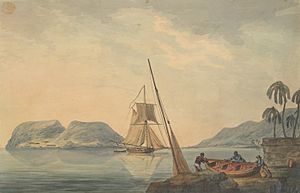Charles Cathcart, 8th Lord Cathcart facts for kids
Charles Cathcart, 8th Lord Cathcart (born 1686 – died 20 December 1740) was an important officer in the British Army. Before 1732, people knew him as The Honourable Charles Cathcart. He had a long career serving his country in battles and at the royal court.
Contents
His Family Life
Charles Cathcart was the second son of Alan Cathcart, 7th Lord Cathcart. His mother was Elizabeth, whose father was James Dalrymple, 1st Viscount of Stair. Charles had an older brother, also named Alan, who sadly died at sea in 1699.
His Career
Serving in the Army
Charles Cathcart joined the army when he was seventeen years old. In 1704, he led a group of soldiers called a company. They were fighting against the French army near Holland.
In 1706, he joined a famous cavalry group called the Scots Greys. This group fought very well at the Battle of Ramillies that same year. Charles was known as a brave and dedicated officer. He fought in many big battles with the army led by the Duke of Marlborough.
In 1709, he became a major in the Scots Greys. Soon after, he became a lieutenant-colonel, which is a higher rank.
Fighting in Scotland
In 1715, a rebellion started in Scotland led by the Earl of Mar. Charles Cathcart joined the forces fighting against the rebels. On 23 October, he led a group of dragoons (soldiers on horseback). They attacked a group of rebels, defeating them and capturing many.
He also fought at the Battle of Sheriffmuir on 13 November 1715. His quick attack with the Scots Greys helped defeat part of the rebel army. Because of his bravery, he was given command of the 9th Foot regiment in 1717.
Later Military Ranks
Over the years, Charles Cathcart commanded different regiments:
- In 1728, he led the 31st Regiment.
- In 1731, he moved to the 8th Dragoons.
- In 1733, he became colonel of the 7th Horse (later known as the 6th Dragoon Guards).
He was promoted to brigadier-general in 1735 and then to major-general in 1739.
Expedition to America
In 1740, the British decided to attack Spanish lands in America. Lord Cathcart was chosen to lead this important expedition. He was made the commander-in-chief for the army in America. Sadly, he died on the journey on 20 December 1740. He was buried on a beach in Portsmouth, Dominica, where a monument was built to remember him.

Working for the King
When King George II became king in 1727, Charles Cathcart was given a special job. He became a Groom of the Bedchamber, which meant he helped the King in his private rooms.
In 1732, he inherited the title of Lord Cathcart. The next year, in 1733, he became a lord of the bedchamber to King George II. This was another important role in the royal household.
Lord Cathcart was also chosen to represent Scottish nobles in Parliament several times. He was also in charge of two important forts: Duncannon Fort and Londonderry.


